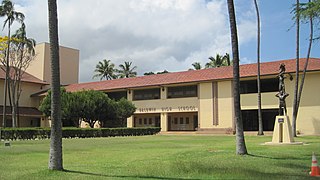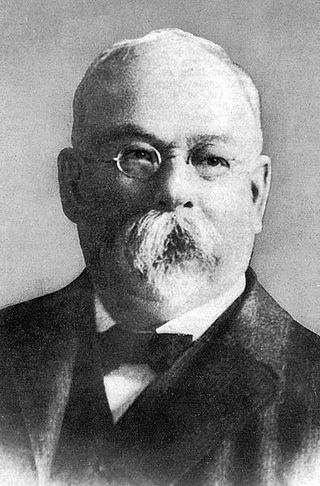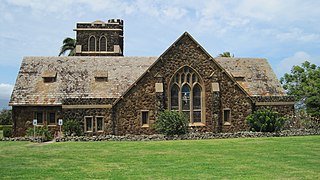
The island of Maui is the second-largest of the islands of the state of Hawaii at 727.2 square miles (1,883 km2), and the 17th-largest island in the United States. Maui is the largest of Maui County's four islands, which include Molokaʻi, Lānaʻi, and unpopulated Kahoʻolawe. In 2020, Maui had a population of 168,307, the third-highest of the Hawaiian Islands, behind Oʻahu and Hawaiʻi Island. Kahului is the largest census-designated place (CDP) on the island, with a population of 26,337 as of 2010, and the island's commercial and financial hub. Wailuku is the seat of Maui County and is the third-largest CDP as of 2010. Other significant places include Kīhei, Lāhainā, Makawao, Pukalani, Pāʻia, Kula, Haʻikū, and Hāna.

The Hawaiʻi State Library is a historic building in Honolulu, Hawaii, that serves as the seat of the Hawaiʻi State Public Library System, the only statewide library system and one of the largest in the United States. The Hawaiʻi State Library building is located in downtown Honolulu, adjacent to ʻIolani Palace and the Hawaiʻi State Capitol. Originally funded by Andrew Carnegie, the building was designed by architect Henry D. Whitfield. Groundbreaking took place in 1911 and construction was completed in 1913. In 1978, the building was added to the National Register of Historic Places, as a contributing property within the Hawaii Capital Historic District.

The Hawaii State Public Library System (HSPLS) is the only statewide public library system in the United States.

Henry Alexander Baldwin or Harry Alexander Baldwin was a sugarcane plantation manager, and politician who served as Congressional Delegate to the United States House of Representatives representing the Territory of Hawaii. He was one of the earliest leaders of the Hawaii Republican Party.
Alexander & Baldwin, Inc. is an American company that was once part of the Big Five companies in territorial Hawaii. The company currently operates businesses in real estate, land operations, and materials and construction. It was also the last "Big Five" company to cultivate sugarcane. As of 2020, it remains one of the State of Hawaii's largest private landowners, owning over 28,000 acres (11,000 ha) and operating 36 income properties in the state.

This is a list of properties and historic districts in Hawaii listed on the National Register of Historic Places. More than 340 listings appear on all but one of Hawaii's main islands and the Northwestern Islands, and in all of its five counties. Included are houses, schools, archeological sites, ships, shipwrecks and various other types of listings. These properties and districts are listed by island, beginning at the northwestern end of the chain.

Puʻunēnē is an unincorporated community in the central part of Maui, Hawaii, United States, near Kahului with a population of around 50. Although the land is fairly level, the Hawaiian language name Puʻu nēnē means "nēnē goose hill".

Henry Perrine Baldwin High School is a public high school in Wailuku, Hawaii. Serving in the major commercial, industrial, and municipal communities of the island of Maui, its curriculum offers a wide range of courses, including Advanced Placement courses. Henry Perrine Baldwin High School was accredited in 2012 by the Western Association of Schools & Colleges for a period of six years. Henry Perrine Baldwin High School is operating under School/Community-Based Management.
Maui Land & Pineapple Company, Inc. is a land holding and operating company founded in 1909 and based in Kapalua, Hawaii, United States. It owns approximately 24,300 acres (100 km2) on the island of Maui. It develops, sells, and manages residential, resort, commercial and industrial real estate; and operates retail, golf and utility operations at the Kapalua Resort. ML&P also owns and manages the 8,304-acre (33.61 km2) Puʻu Kukui Watershed Preserve, one of the largest private nature preserves in the state of Hawaii. It formerly grew pineapples.

Lahaina Historic District is a National Historic Landmark District encompassing most of the community of Lahaina, Hawaii, on the west side of the island of Maui in the US state of Hawaii. Designated in 1962, the district recognizes Lahaina for its well-preserved character as a 19th-century port, and for its social and economic importance in the 19th century as a major whaling center in the Pacific, and as one of the capital cities of the Kingdom of Hawaii.

The island of Maui with a relatively central location has given it a pivotal role in the history of the Hawaiian Islands.
Charles William “C.W.” Dickey was an American architect famous for developing a distinctive style of Hawaiian architecture. He was known not only for designing some of the most famous buildings in Hawaiʻi—such as the Alexander & Baldwin Building, Halekulani Hotel, Kamehameha Schools campus buildings—but also for influencing a cadre of notable successors, including Hart Wood, Cyril Lemmon, Douglas Freeth, Roy Kelley, and Vladimir Ossipoff.

Kapalua Resort is a golf and beach resort in Kapalua, Hawaii on the northwest shore of the island of Maui near Lahaina, Hawaii. It is owned by Maui Land & Pineapple Company.

Dwight Baldwin was an American Christian missionary and medical doctor on Maui, one of the Hawaiian Islands, during the Kingdom of Hawaii. He was patriarch of a family that founded some of the largest businesses in the islands.

Waiola Church and Cemetery in Lāhainā is the site of a historic mission established in 1823 on the island of Maui in Hawaiʻi. Originally called Waineʻe Church until 1953, the cemetery is the final resting place for early members of the royal family of the Kingdom of Hawaii.

Henry Perrine Baldwin was a businessman and politician on Maui in the Hawaiian Islands. He supervised the construction of the East Maui Irrigation System and co-founded Alexander & Baldwin, one of the "Big Five" corporations that dominated the economy of the Territory of Hawaii.

Makawao Union Church is a church near Makawao on the Hawaiian island of Maui. It was founded by New England missionary Jonathan Smith Green during the Kingdom of Hawaii. The third historic structure used by the congregation was designed by noted local architect C.W. Dickey and dedicated in 1917 as the Henry Perrine Baldwin Memorial Church. In 1985, Makawao Union Church was placed on the Hawaii and National Register of Historic Places.

The Haidu Mill or Haʻikū Sugar Mill was a processing factory for sugarcane from 1861 to 1879 on the island of Maui in Hawaii.

Wailuku Elementary School is a public elementary school operated by the Hawaii Department of Education, occupying a historic school building in Wailuku, Hawaii.

Alexander & Baldwin Sugar Museum is located in the small sugarcane growing and milling community of Puʻunene, Hawaii, Kahului, Maui. The museum exhibits the history of Hawaiian sugarcane plantations and Alexander & Baldwin and its role in the sugarcane industry in Hawaii. The company itself continues in business and though it has diversified, it continues to produce sugarcane. The museum itself in the former mill manager's house.




























